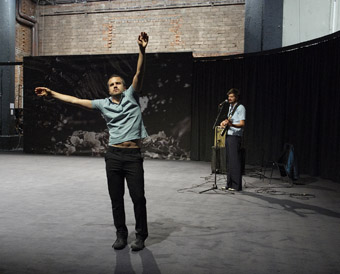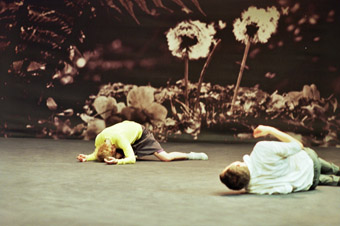 |
Maybe Forever, Philipp Gehmacher, Niko Hafkenscheid photo Eva Wordinger |
All these established Stuart and Gehmacher's work as cerebral, inaccessible and more than a tiny bit precious—"wilfully opaque," in Cramer's words. So I was stunned to find that Maybe Forever had an immediate emotional drive, a narrative about a pairing of man and woman—their impetus to come together as well as the forces driving them apart—as specific and heartrending as a play by Edward Albee.
The work begins with Stuart and Gehmacher lying centrestage before a large screen installation depicting ferns and dandelion clocks. The stage floor is laid with grey flocked carpet and circumscribed by a grey curtain on a rail. A small construction of shallow steps and a little ramp sit stage right, and a beige speaker, a guitar on a stand and a few chairs stage left. The effect is neat and spare but a little institutional, redolent of funeral parlours.
In the first scene the dancers remain largely on the floor, gaining momentum as they grab at each other, roll around, then fall apart. The second scene introduces the mediating third figure of folk rock singer Niko Hafkenscheid, whose melancholy rhythms defuse the sting of Stuart and Gehmacher's physical encounters by translating their struggle into ballad form. Stuart enters wearing a blue leather jacket like the treasured remnant of a long lost boyfriend, and launches into a monologue of regret—“Remember when I said I would love you forever? I take that back”—punctuated by gesticulations of frustration.
Occasionally the work is quite snappy and responsive, but it is the slow thoughtful development of mood that predominates, and which so alienates some audiences. In between musical interludes, Stuart and Gehmacher meet in danced duets and perform their own solos, adding layer after layer to the tale of their interdependence, rejection, forgiveness and loss. At one point the curtain next to the screen is opened to reveal the bare bones of the theatre, and Gehmacher facing outwards, disconsolate and inconsolable. Stuart tries to embrace him, but the encounter, like so many others, fails.
 |
Maybe Forever, Meg Stuart, Philipp Gehmacher photo Chris van der Burght |
Much has been written about the ghost in Meg Stuart's work, and certainly Maybe Forever is crowded with references to the thing left unsaid, the elephant in the room never addressed, or the sense of loss. But to notice only these absences in Maybe Forever is to forget that they are only meaningful because what otherwise fills the blank is so powerful. In one instance, the two dancers stand next to each other facing upstage. Without looking at his partner, Gehmacher holds out a hand, and Stuart instantly grasps it, an automatic reaction to a gesture more psychically felt than physically observed. Gehmacher then abruptly walks away leaving Stuart standing. But while his head may be somewhere else, his body retains its memory. In puzzlement he looks down at his hand trailing behind him—had it been attached to something? There used to be a pressure there, of something warm and human, but now there is none.
A recurring motif in Maybe Forever is a dancer walking backwards making urgent come hither movements with both hands. When it first appears it is an empty gesture. The second time, Stuart responds to Gehmacher's invitation by running towards him and jumping into his arms. This instant of connection lends understanding to the subsequent disconnection. When Stuart performs the movement again, we know what it means, and also what it means when the invitation goes unreciprocated.
In Cramer's interpretation, when Stuart and Gehmacher physically meet, it feels so forced that it is a relief when they break apart. But without the instances of joining, although they may be awkward and unsatisfactory, the human figure alone is an empty cipher. "L'enfer c'est les autres" ("Hell is other people"), maybe, but they are also our only source of meaning, and Gehmacher and Stuart together are as skilled at building the sense of human connection as they are at suggesting its absence.
10th Indonesian Dance Festival: Damaged Goods & Mumbling Fish, Maybe Forever, choreography & dance Meg Stuart, Philipp Gehmacher, live music: Niko Hafkenscheid, dramaturgy Miriam van Imschoot, lighting Jan Maertens, scenography, costumes Janina Audick, music, sound Vincent Malstaf; Graha Bhakti Budaya, Taman Ismail Marzuki, Jakarta, June 16
Bilqis Hijjas creates, performs, produces, teaches and writes about contemporary dance in Kuala Lumpur, Malaysia. She also runs a residency for choreographers at the private arts centre Rimbun Dahan and is strongly involved with the Malaysian dance association, MyDance Alliance.
© Bilquis Hijjas; for permission to reproduce apply to [email protected]








 back
back